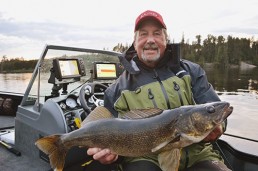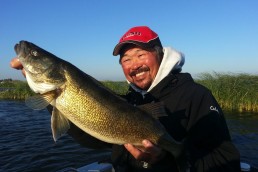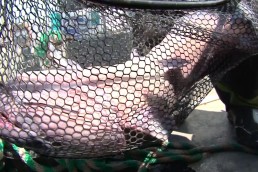Structural Edges Gather Fish: find and Fish ‘Em
SHARE THIS POST
The word “positioning” is a rather awkward way to begin a fishing article, but there is no better word to describe an edge.
For years, anglers in the know have been fishing edges of every feasible type of structure imaginable, and have found places fish inhabit, amazing even the non-believers. Make no mistake, fishing the edge of structure of any size will enhance your success and give you a better understanding of being consistent.
For decades, when the “Father of Structure Fishing,” Buck Perry, tried to drill it into our heads that fishing structure was a relatively easy equation, no one could understand why certain species inhabited different types of specific locations. But Perry was way ahead of his time and passed on these theories we live by today.
The Lindners understood the mechanics of edges better than anyone and were mopping up on fish wherever their caravan took them.
As a professional guide I have always been intrigued by places that fish will position themselves. I realize that the time of the year and food sources can throw a monkey wrench into the entire process, but edges of structure have helped me to be consistent. Walleyes, bass, northern pike, muskies and panfish all relate to structural edges, but knowing when and where to fish these primo locals will always be a challenge.
I love to catch any fish, but walleyes have always been my trademark, and also have haunted me at times with their attitudes. Years ago, there were thoughts of walleyes locating themselves in relatively deeper water and only coming out at night to feed. Those nonsense theories have come and gone and we know that they are very adaptable to countless locations at different times of the day. Excellent examples of structural elements where edges significantly play an important role are sunken islands, weed beds, points, inside turns, shoreline breaks, rock piles, standing timber and even open-water areas. These define locations of walleyes. And, forage is also a significant factor that can at times dictate specific edges we fish.
Early and late in the season, jig fishing is my bread and butter when it comes to fishing edges of most structural elements. It can be a search “weapon” when setting up on the edge of weed beds, a long protruding point, when back-trolling a break line, or when fishing a specific spot. A VMC Moon Eye jig tipped with a minnow, half a crawler or a plastic tail can be a tough hombre when it comes to quickly checking out specific edges. My second choice is often a shallow- or deeper-diving crankbait like a Rapala Husky Jerk, a #7 or #8 Shad Rap, a number 7 Scatter Rap. These have put countless numbers of walleyes in the boat for me. Crankbaits are also great search baits and can trigger strikes in any given situation. Keeping your boat away from the edge though is critical, and in many situations, can make the difference. Deeper edges where I may be back-trolling chasing walleyes are less susceptible to spooking fish because of the depth.
Are you enjoying this post?
You can be among the first to get the latest info on where to go, what to use and how to use it!
I use my electronics like a surgeon dissecting every nook and cranny of structure that I encounter. With my Humminbird’s side imaging and down imaging features, I can pick apart the locations of different species on edges, mark their locations and then come back and fish them. Except for deep structure, many times I will cast to the edge believing the species I intend to catch are located in heavy vegetation or rocks that are at times impossible to read accurately. Edges have been ambush points for fish and provide just what is needed for contact. Assisting in the positioning theory always will include the proper use of my electric trolling motor or my freshwater transom mount. They have their equal uses when I am positioning my boat to stay on the fish. One advantage I have is that these systematically keep me on my spot by incorporating an internal method of adjusting wind, current and waves to stay on the location.
Don’t ever get caught up in the statement, “They just weren’t biting today.” There is nothing further from the truth.
One of my good friends and mentor, Al Lindner, told me once, “There are always fish biting somewhere; we just have to find them.”
Have you ever noticed at a tournament or when working with a professional guide there are always exceptions to the rule on a slow or adverse fishing day and someone then finds fish that are biting? The good ones can react to change and have backup plans to inject into their game plan for success.
Fishing the edges of structure no matter their location or makeup will put fish in your boat. Proper presentation and the right bait are important, but “living on the edge” will create a better understanding and increase your odds of success.
For more information or to book a day on the water, visit Tom Neustrom’s site at mnfishingconnections.com.
MWO
SHARE THIS POST
Did you enjoy this post?
You can be among the first to get the latest info on where to go, what to use and how to use it!



